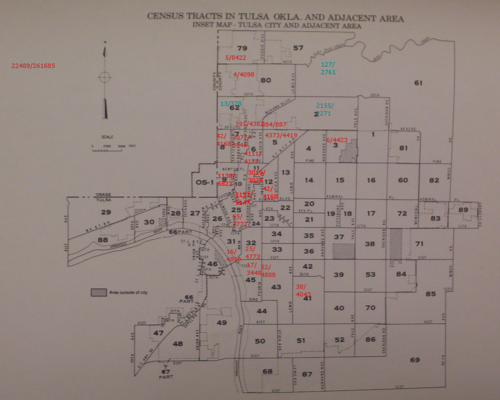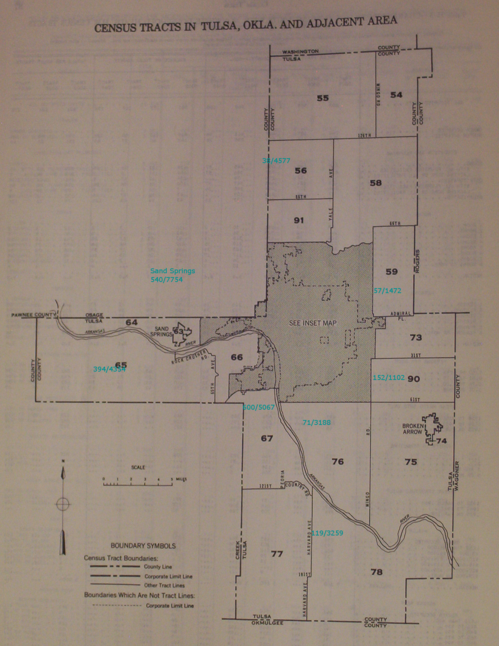How integrated is Tulsa?
I came across some research, based on the 2000 U. S. Census, calculating various indicators of racial integration in the nation's 100 most populous metropolitan areas. It points to an impressive degree of progress over the last half century in Tulsa.
According to that paper, 16.3% of the City of Tulsa's population and 9.4% of the Tulsa Metropolitan Statistical Area (MSA) was African-American in 2000.
The researchers analyzed the racial composition of each census block, sorting them into four categories:
- >= 20% Black and >= 20% White (the authors of the study term these "black-white integrated blocks")
- < 20% Black and > 50% White
- > 80% Black
- Other Mixture
A census block is the smallest unit of census statistics. Streets, creeks, railroads, section lines, city limits all serve as census block boundaries. For example, a city block split in two by a railroad track would result in two census blocks.
In the Tulsa MSA, there were 75,471 African-Americans in the 2000 Census. 28.0% lived on blocks where the population was at least 20% black and at least 20% white. 28.7% lived on blocks where the population was less than 20% black and at least 50% white, 36.0% lived on blocks where the population was at least 80% black, and 7.4% on blocks with some other racial mixture.
Put another way, in 2000 64% of African-Americans in the Tulsa metro area lived on racially diverse blocks. In 1960 that number was below 10%. While there is a concentrated area of black population in north Tulsa, two-thirds of Tulsa's black population is scattered across the map.
I don't have census block data on population by race in 1960, but I do have that data by census tract -- areas of a few dozen blocks, often about a 1/2 square mile in area. In 1960, blacks were 8.7% of the City of Tulsa's population. In 1960, 91.6% of Tulsa's blacks lived in six census tracts -- 2, 5, 6, 7, 10, and 11 -- about 4 sq. mi. area bounded roughly by Cincinnati Ave on the west, Mohawk Blvd on the north, the Santa Fe tracks on the east. Outside of the City of Tulsa, the only significant clusters of blacks in Tulsa County in descending order, were the rural part of tract 2 (bounded by Mohawk Blvd, Yale, Peoria, Apache and 36th St. N), the city of Sand Springs, tract 67 (likely that most were in the South Haven subdivision near 51st St and 33rd West Ave), tract 76 (likely around Rentie's Grove), and tract 90 (likely in and around Alsuma)
So we've gone from over 90% of blacks living in a small part of the city in 1960 to living all over the metro area -- 64% outside of predominantly black areas -- in 2000. That seems like progress to me, but the authors of the research don't rank Tulsa as significantly integrated (see their maps of Tulsa) because there are so few blocks on which the population is at least 20% black and at least 20% white. In a city where the overall black population is less than 20%, that doesn't seem like a good measurement of integration.
Of course, geographical integration isn't necessarily a good measure of social integration either, as we tend to connect with people we know from church, school, and work and may not spend much time with our own neighbors.
Here are a couple of maps from the 1960 census reports, showing tracts in and round the City of Tulsa and for the rest of Tulsa County. I've superimposed pairs of numbers on some of the tracts. The first number is the number of blacks, the second is the total population of the tract. Red numbers are inside the city limits; blue numbers are outside. Click the pictures to view full size:
0 TrackBacks
Listed below are links to blogs that reference this entry: How integrated is Tulsa?.
TrackBack URL for this entry: https://www.batesline.com/cgi-bin/mt/mt-tb.cgi/6156

